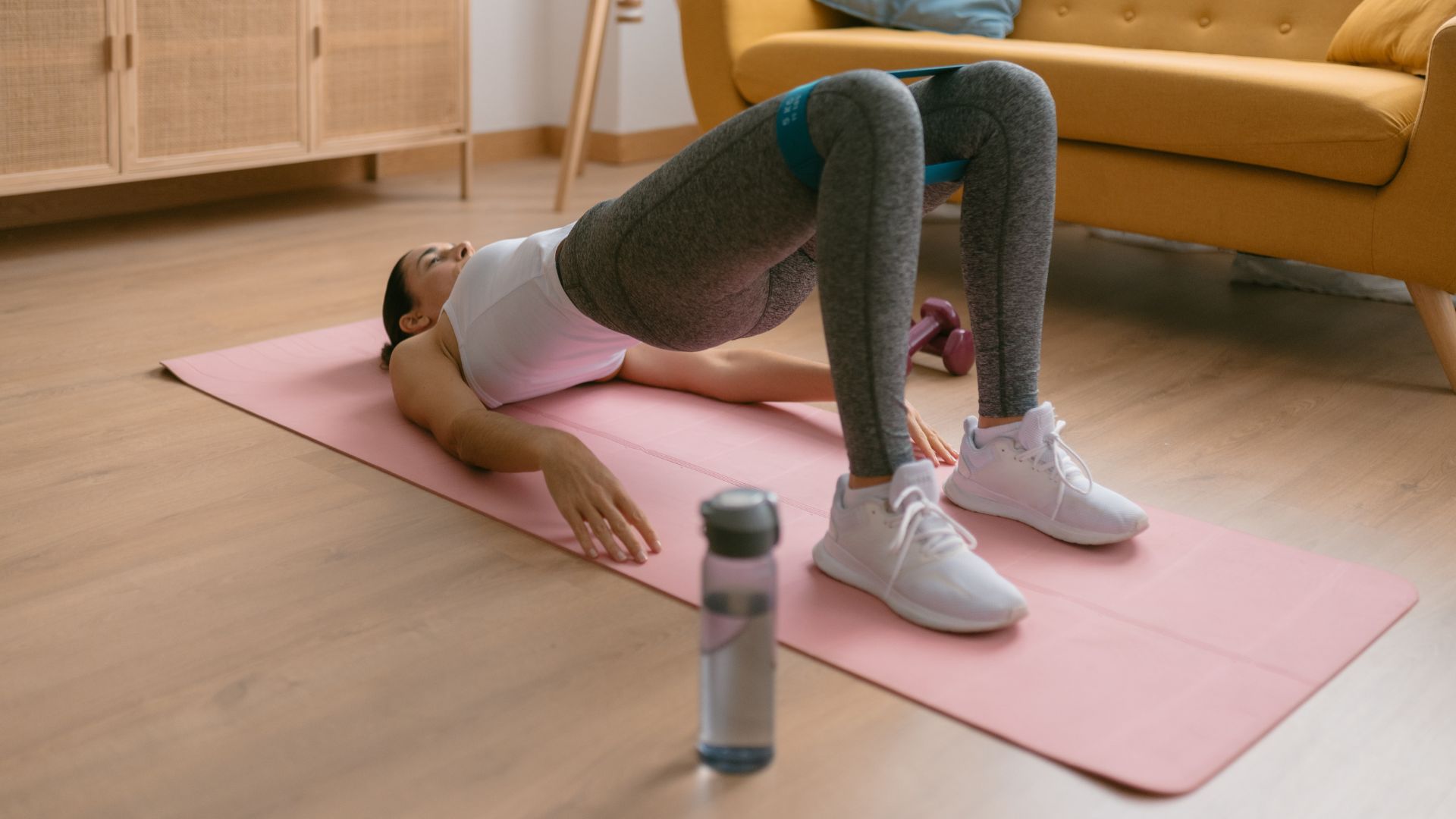I said goodbye to sleepy glutes with this one powerhouse move - here's how to do the glute bridge exercise
The glute bridge exercise is hailed as a simple yet effective way to strengthen not only the glutes, but also the hips, back and more


It’s an inescapable fact of modern life that many of us spend vast swathes of our time sitting down, so you can imagine my happiness when I discovered the glute bridge exercise.
Whether at work, travelling, or chilling at home, it’s estimated that we’re spending around nine hours per day sitting down - and it’s not news to any of us that this isn’t doing us any favours.
One area that really suffers when we’re (quite literally) sitting on it too long is our glutes. The largest and most utilised muscle group in the human body, the glutes are composed of three muscles known as the gluteus maximus, gluteus minimus, and gluteus medius. Despite their importance, the glutes are notoriously ‘lazy’, meaning they can essentially switch off when underused or if you don't do glute exercises, resulting in lower back pain, numbness, hip and knee problems and more.
All is not lost: studies show that the glute bridge exercise is highly effective in activating the entire gluteal area, counteracting all those hours of perching on our posteriors. The clamshell exercise and the fire hydrant exercise can help with this, too.
"Increasing the strength of your glutes is key for correcting the effects of sitting for long periods of time," shares personal trainer and strength coach Charlotte Dunnell. “Underuse can cause our glute muscles to atrophy, which means they decline in strength and/or size."
What is the glute bridge exercise?
For the uninitiated, we’ll start with the basics. Imagine lying on your back and thrusting your hips up into the air as far as you can, and you’re essentially doing a glute bridge.
"The glute bridge is a supine (lying on your back) hip-extension exercise that primarily works the glutes, but also the hamstrings, and deep core muscles,” explains master trainer at Third Space, Lucie Cowan. “From a starting position with your knees bent and feet on the floor, you extend the hips up toward the ceiling, creating a straight line from shoulders to knees at the top of the movement.”
Sign up to our free daily email for the latest royal and entertainment news, interesting opinion, expert advice on styling and beauty trends, and no-nonsense guides to the health and wellness questions you want answered.
Primarily a bodyweight workout move, the exercise can also be progressed by adding in weights or a resistance band for extra spice.
How to do the glute bridge exercise
- Lie on your back with knees bent and feet directly underneath your knees, arms at your sides with your palms down.
- Take a breath in, brace your core, and keep a neutral spine.
- Keep your chin tucked down slightly so your neck is neutral.
- Exhale and press through your whole foot, heels and toes, to lift your hips. Think about driving the hips toward the ceiling by squeezing the glutes.
- Aim to form a straight line from your shoulders to your knees at the top. Squeeze the glutes hard for one to two seconds.
- Slowly lower the hips back to the floor with control (don’t just drop). Reset your brace and repeat.
- Keep the ribs down, and don’t let the knees cave in.
- If you feel the movement mainly in your hamstrings or lower back, move your feet slightly forward or until you feel it in the glutes.
- Repeat the exercise for 6 to 12 repetitions.
How to do a weighted glute bridge
Confident you’re crushing your glute bridges? It’s time to progress by adding some weight, and therefore challenge, to the move. You can achieve this using dumbbells, a kettlebell, a weight plate or a barbell across your hips. Remember, start small and build up gradually.
Personal trainer Emma McCaffrey advises the following steps:
- Focus on placement: Lie down and place the chosen weight horizontally across your hip crease (use a pad or towel for cushioning).
- Security: Secure the weight with both hands to keep it from rolling.
- Execution: Perform the bridge movement exactly as you would the bodyweight version. Drive through your heels, lift, squeeze at the top, and lower slowly.
If the move still isn’t giving you the burn you’re after, try adding a few pulses at the top of the exercise, like you would with the leg raises exercise.
What are the benefits of the glute bridge exercise?
While the move looks and, in fact, is simple, we shouldn’t overlook its many benefits. “The glute bridge offers a wide range of benefits beyond just strengthening your glutes,” shares personal trainer and founder of Owning Your Menopause, Kate Rowe-Ham.
“By targeting the largest muscles in your body, you build power and endurance in an area often weakened by prolonged sitting.”
It's a full-body move
Think you’re just working your glutes? Think again. "The glute bridge is an incredibly versatile exercise that targets many different muscles at the same time,” says Dunnell.
“While it primarily targets the gluteal muscles, it also works the core, the hamstrings (muscles on the back of the legs), erector spinae (muscles running on either side of the spine) and quadriceps (muscles on the front of the legs).”
It strengthens the posterior chain
While the move is simple enough, it packs a real punch when it comes to strengthening what’s known as the posterior chain. This term refers to the network of muscles that run the entire length of the back of our body, from our ankles to the legs, through the spine to the nape of the neck.
A strong posterior chain through the years is essential, making glute bridges one of the best exercises for longevity. Not only does it help you stay fully mobile with age, but by stabilising the knee and hip joints, it can reduce the risk of injury.
It improves functional fitness
Even if you’ve never been athletically disposed, bear with us here. The movement pattern of the exercise mimics the drive we use not only when working out, but also in our everyday lives, too.
“Stronger glutes improve force production for many movements,” says Cowan. “This equates to more power, which will boost your athletic performance, for example, when running, jumping and lifting.
“Improved hip drive contributes to depth and power in gym moves such as squats and cleans, while the movement pattern mirrors the sit-to-stand and stair-climbing actions that we all use every day. Improving hip extension makes everyday tasks, such as getting up from a chair, climbing stairs, carrying children/shopping, easier and safer, especially for older adults.”
It helps prevent lower back pain
When our glutes are weak, it tends to be our backs that pick up the load and overcompensate, leading to tightness, pain and injury. While you might not think of the glute bridge exercise as one of the best back exercises to do, it certainly helps.
“Strong glutes work to support the lower back and hips, helping to reduce discomfort and improve posture by encouraging hip extension without relying on the lumbar spine,” explains Rowe-Ham. “Bridges also improve knee alignment, teaching the legs to move in a way that protects the joints during activities such as walking, running, or lifting.”
It boosts pelvic floor strength
“The movement requires deep core engagement to maintain stability and prevent the lower back from arching,” notes McCaffrey. “This helps strengthen the core and pelvic floor, which further supports the spine and improves overall balance.”
It's accessible
Last but certainly not least, the move is accessible to pretty much anyone and everyone, making it (dare we say) the perfect entry-level move for beginners. Not only this, it can be levelled up for those gym pros with more weights or a set of resistance bands.
“It’s easy to teach and perform without equipment, so is ideal for beginners, yet fully scalable for athletes using heavy barbells or one-leg progressions,” agrees Cowan.
How long should you hold the glute bridge for?
“If you’re focused on building strength and hypertrophy (muscle growth), I’d advise using a moderate to heavy weight and holding the top position (hip extension) for around two to five seconds. Aim to perform six to 12 reps per set," says Cowan.
However, it ultimately depends on what your goals are and where you’re starting from. It goes without saying that beginners won’t be able to complete as many reps and sets as a seasoned gym-goer.
“To build endurance and maximise glute activation, use a lighter weight or stick to bodyweight. Hold the top position for 10 to 30 seconds, and repeat for several rounds. Finally, if you’re working on isometric strength (static hold training), hold the bridge at the top for 20 to 60 seconds with a moderate load, for between two and four sets.”
Anna Bartter is a freelance health and fitness writer who writes across a range of publications, including woman&home, Marie Claire, Stylist, Psychologies and more. She's never happier than when trying out a new wellbeing trend, and when she's not writing, she's most likely to be found at a reformer Pilates class.
You must confirm your public display name before commenting
Please logout and then login again, you will then be prompted to enter your display name.

